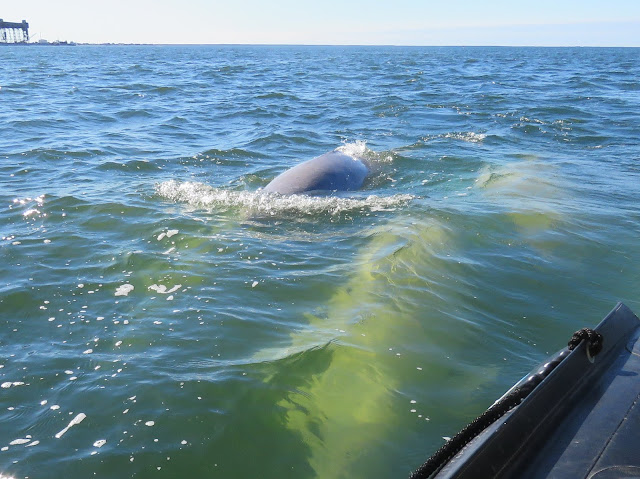We wake to a sunny, but cold morning. Today is the day of the Beluga Whales. Remembering the Zodiac outings in Antarctica, it is definitely a many layers day.
We are picked up at nine by Judd and the trainee girl Jess and taken to the mooring of the zodiacs in the little bus.
As soon as we get out into the river, the Belugas are all around us. Some come very close to the boat. They are so inquisitive.They also have a permanent smile on their faces.
Beluga calves are born a darkish grey. The colour does not turn white until they are 7 - 9 years old.
Calves at birth are around 1.2 to 1.8 metres long and weigh 50 - 60 kg. The gestation period is 14 -15 months and the calves nurse for up to 18 months.
A female Beluga typically gives birth about every 3 years to just one calf.
Beluga females reach maturity between 4 - 7 years, males between 7 - 9 years.
At that rate, a population explosion is not very likely.
Belugas are one of the toothed whale species, although they don't chew their food but swallow it whole. Their teeth are used mainly for tearing.
They eat any kind of fish that comes their way, about 25 kg of it every day. Belugas come up to breathe like other marine mammals, but they do not spray any water fountains like some. They can hold their breath for up to 15 minutes.
The bulbous forehead is called melon. They can blow it up or deflate it. It helps them make their canary like sounds which are, of course, their echolocation. We all learn to speak Beluga and they do come to us. So cute.
The vertebrae in their neck are not fused which means they can move their head up and down as well as sideways.
Their flippers are short and rounded, rather like paddles. All these quirky traits are, of course, designed to make them as agile as they need to be in their environment.
And the sun is definitely still out, but the temperature is not rising noticeably.
We have now arrived at Prince of Wales Fort on the other side of the river mouth and are disembarking for a walk up the hill on the timber walkway.
Not far along, we see a goose nest, quickly abandoned by the adult birds.
More wildflowers. I believe this particular one is apparently toxic, but it is just about the only one. Everything else is either edible or medicinal or both.
Judd points out various berry plants, among others this wild raspberry. The papery looking flower below is a remnant from last summer. It has somehow survived the winter.
The Prince of Wales Fort was built in the typical French star shape design which was supposed to make it impossible to conquer.
Samuel Hearne was in charge of the fort. With him were not soldiers, but a band of very young lads doing carpentry, stone masonry, leather work etc and probably had little idea of how to fire a big cannon.
And so it came that Admiral La Pérouse was able to sail in so close that all they could do was raise the white flag and invite him in to be plundered and taken prisoners.
The walls of the fort have to be repaired and strengthened every Summer as snow and ice cause them to crack. The workmen have put a decent set of stairs up for us to climb to the top.
All these cannons were disabled and the powder stores blown up by Admiral La Pérouse and his men. That was enough to render The Prince of Wales Fort useless. Read more about the history by clicking on the link.
Samuel Hearne during his time had made a couple of attempts to find copper mines farther north, but failed. Chief Matonabbee offered to help him and together they set off, accompanied by native hunters and women who knew how to make warm clothing and feed them.
Matonabbee spoke several languages, including some English.
Several tribes of natives had settled around the Fort and provided the men with food and clothing as well as the furs for trading. Matonabbee with his language skills was the ideal chief.
As we are walking back to the zodiac, a goose suddenly getting up off the ground and walking away.
Just as we think we're going to find the nest, another goose quickly gets up and walks off. The first one was pop, the decoy.
And then they just traipse around as if to say: Nest? What nest? We don't know anything.
It is now time to head back to the harbour as the tide is going out and we risk getting stuck on sand banks if we don't hurry up.
The Belugas, of course, don't have any such concerns.
It is well and truly lunchtime when we return to the Lodge. I spend the best part of the afternoon doctoring my many photos, especially straightening them so the ocean doesn't run out of the pictures.
Today has been the highlight of the trip so far.



















































































No comments:
Post a Comment
Note: only a member of this blog may post a comment.